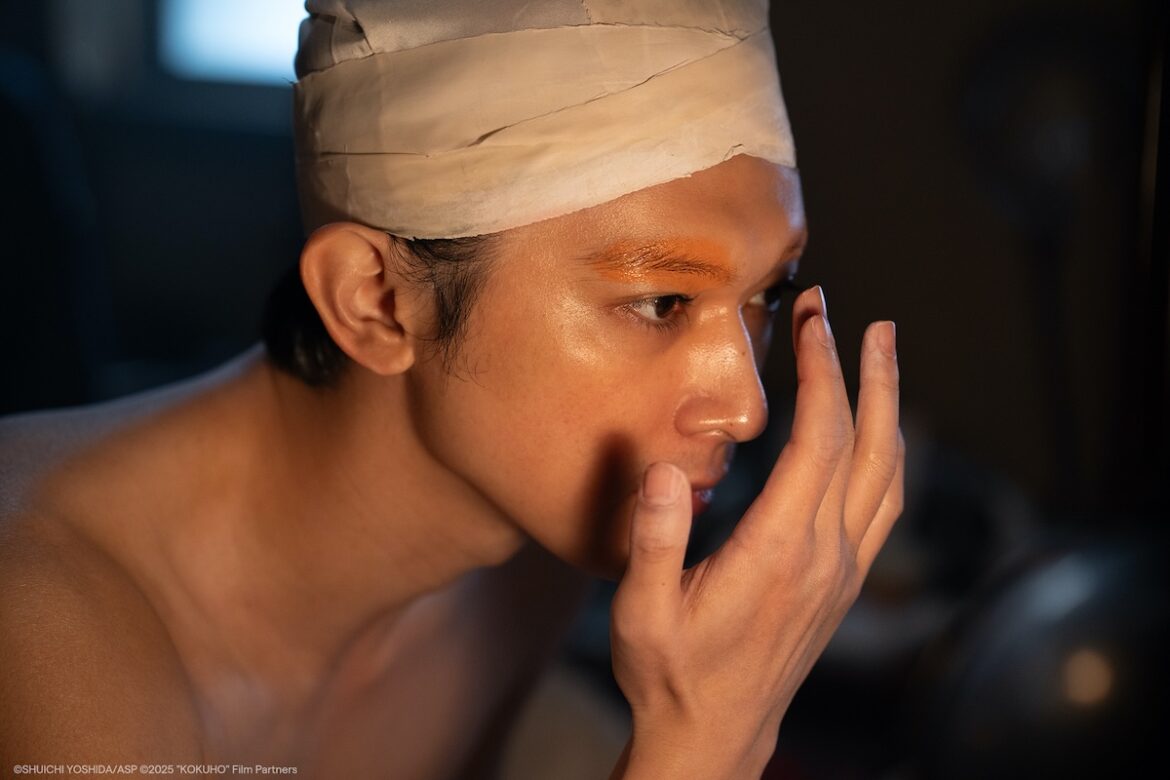Most people are familiar with the Japanese theatrical genre Kabuki from its white-faced performers and their exaggerated poses and facial expressions, even if never having seen an actual production. The eye-popping new film “Kokuho” may serve as the next best thing to attending a performance, as it features many scenes from popular Kabuki plays and dances. A love letter to the art form, the feature revolves around two actors who rise up through the ranks of an Osaka-based troupe in a decades-spanning tale of friendship, rivalry, ambition, sacrifice, and dedication.
After a fantastic prologue involving an amateur Kabuki production and a gang-related killing at a New Year’s Eve party in 1964, the movie settles down a bit at a family-run theater school and group headed by its main attraction, Hanjiro Hanai (the great Ken Watanabe). Hanjiro takes in an orphan, adolescent Kikuo, after his gangland (yakuza) father is murdered. Pairing him with his son, Shunsuke, the respected actor teaches them the craft of Kabuki, the practice of which often requires physical and emotive precision.
Kikuo demonstrates a natural affinity with the form, with the story hinting at friction between the boys, though director Sang-il Lee avoids outright acrimony to instead mine a competitive tension steadily over his luxuriant three-hour film adapted from a novel by Shūichi Yoshida.
As the two grow into young adults under Hanjiro’s demanding tutelage, Kikuo and Shunsuke become friends, even performing together in their first official show. But when the Kabuki master chooses Kikuo to replace him in a production instead of his own son, their bond frays, leading into the movie’s second hour.
 Still from ‘Kokuho.’ Via GKIDS
Still from ‘Kokuho.’ Via GKIDS
Some viewers may have a difficult time squaring Kabuki’s hierarchical, family lineage-based structure with the more democratic conception of the arts and merit-based casting. Indeed, other events, behaviors, and beliefs expressed by the characters may prove inscrutable, particularly for Western audiences. Yet one of the film’s strengths is that it frequently makes no attempt to normalize its milieu, psychologize its characters, or explain the rigid strictures in Japanese culture or the art of Kabuki, the last of which is portrayed both matter-of-factly and wondrously.
During scenes depicting vignettes from Kabuki works, on-screen text informs us of the titles and basic stories. This often constitutes the only information provided about the pieces, leaving the occasional song lyric untranslated for non-Japanese-speaking viewers and the meaning of certain gestures and movements unclear to those unfamiliar with the form, like myself.
The “strangeness” of some of these actions and music — combined with the heightened tenor of the actors’ makeup, the fact that men play all roles, even the female ones, and the exquisite sets and costumes — creates an intoxicating befuddlement at times, with very little context taking us away from the transporting sensory experience.
The tricky situations and tentative emotions of the main characters off-stage sometimes mirror the elaborate choreography and intricate machinations depicted in the Kabuki scenes they star in, such as those from “Temple Maidens” and “Two Lions,” the last of which resembles “The Lion Dance” captured by master Japanese director Yasujiro Ozu.
The melodrama in their lives is kept at a low boil, with only flashes of self-recrimination, exaggerated conflict, and real drama igniting here and there as Shunsuke runs off with Kikuo’s girl while Kikuo rises to the top ranks of the troupe. It’s not until about the film’s third hour, when their fortunes are reversed — with Kikuo forced to do Kabuki “dinner theater” while Shunsuke inherits the family heritage — that director Lee fully embraces the story’s theatricality and reinforces the notion that life and art become increasingly indistinguishable to performers.
Such performers as actors Ryo Yoshizawa and Ryusei Yokohama, who respectively play Kikuo and Shunsuke, contribute greatly to grounding the narrative’s ups and downs and twists and turns in subtle expressions and genuine reactions. Kikuo’s trajectory, in particular, threads a theme from “The Picture of Dorian Gray” that not only solidifies the character’s centrality but also Mr. Yoshizawa’s deft meddling of good looks, egotism, and dark determination.
Beyond the desires and emotions they bring to their characters’ yin and yang lives, the two actors also rise to the daunting task of their various Kabuki roles, with both having studied alongside real practitioners of the art. Of the large, compelling supporting cast, special mention must be made of actor/dancer Min Tanaka’s portrayal of an aged Kokuho, or “national treasure.”
At times, the film swoops too quickly over plot holes and missing details, yet it also draws out quiet moments that resonate with tenderness and passion. In the third act, when Kikuo and Shunsuke reunite on-stage, this hushed intensity transforms into exquisitely heartbreaking high drama, with the cruelty of the oft-quoted phrase “the show must go on” amply illustrated.
Even after this climax, the director has more up his ample sleeve in an epilogue containing additional drama, melodrama, poetry, and beauty. It all makes for a richly rewarding viewing experience, encouraging one to seek out Kabuki at cultural institutions around town or in the land of the rising sun itself.


AloJapan.com